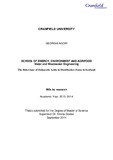JavaScript is disabled for your browser. Some features of this site may not work without it.
| dc.contributor.advisor | Goslan, Emma | |
| dc.contributor.author | Agori, Georgia | |
| dc.date.accessioned | 2015-06-15T14:52:54Z | |
| dc.date.available | 2015-06-15T14:52:54Z | |
| dc.date.issued | 2014-09 | |
| dc.identifier.uri | http://dspace.lib.cranfield.ac.uk/handle/1826/9245 | |
| dc.description.abstract | HAAs are the second most prevalent class of DBPs after THMs in chlorinated drinking water and are of concern due to their potential human health risk. Their concentrations in drinking water are regulated by the US Environmental Protection Agency (US EPA) and other regulatory agencies and are currently under consideration by the European Union to be regulated at 80μg/L. However their monitoring in the distribution system is complicated because several parameters influence their formation and speciation. In addition the kinetics of HAAs and their formation and stability remain largely unidentified. The HAAs are not as chemically or biologically stable as THMs in aquatic systems and their stability may impact their measurement. The levels of HAAs within a distribution system may vary seasonally and spatially. Many studies have shown that their concentration in a distribution system can rise as well as fall. The levels of HAAs in the distribution system could be increased in the presence of residual chlorine or due to the decomposition from other DBPs and be decreased by biodegradation or hydrolysis and abiotic degradation. However biodegradation is likely the major loss process occurring in drinking water distribution systems. This study provides an interesting picture of HAAs levels in distribution water in Scotland. A statistical analysis has been carried out using measurements of HAAs concentrations and other water quality parameters from 298 Scottish water distribution zones in to investigate the relative occurrence and speciation of HAAs, and determine their behaviour in water distribution systems, monitoring differences between zones. This study also allowed evaluation of the impact of seasons on HAAs concentrations and speciation in Scotland’s distribution zones. The results obtained show that the median concentrations of HAA5 is 11.5μg/L. The average HAA5 in distribution systems were about 50% lower than total trihalomethanes (THMs). In 0.7% of the zones under study, the average HAA5 concentration exceeds 60μg/L. These zones are supplied by small WTWs (<3,300 people) and are using chlorination. HAAs concentrations varied according to their water source and the disinfection strategy used. Low HAA5 levels (the median was <5.3 μg/L) were observed in the groundwater systems and higher levels were observed in the surface water systems (the median was 12.4 μg/L). The chloraminated waters have lower HAA5 and THMs levels compared to chlorinated waters, but the difference is not that pronounced. Generally chlorinated HAAs dominated in the waters of the distribution under study. The dominant species were trichloroacetic acid (TCAA) and dichloroacetic acid (DCAA). DCAA and TCAA were present at almost in equal levels in chlorinated waters but DCAA was the dominant group detected when using chloramination. Furthermore seasonal variations of the concentrations of different HAAs species were observed. The concentrations of HAA5 were higher in summer and autumn and lower in winter and spring but the difference was not statistically significant. THMs has a similar seasonal pattern but with a more pronounced variation than HAAs. The median data show almost no seasonal variation for dichlorinated HAAs. However the seasonal variation of TCAA is more pronounced and higher concentrations were detected during summer and autumn.When the data sets from all distribution zones were combined there was a strong correlation between total THMs and HAA5, total THMs and TCAA and HAA5 and total organic carbon (TOC). The spatial variability of HAAs and THMs concentrations in two distribution zones using different disinfection strategies (chloramination and chlorination) was also studied. There has previously been no full scale study in the UK with the attempt to link the behaviour to distribution factors such as microbial water quality or distribution mains material. In both systems THMs generally presented stable and increasing concentration profiles along the system, whereas HAAs increased and decreased, a phenomenon probably related to biodegradation. There is also evidence that abiotic reduction of HAAs is possible in the iron pipes for the chlorinated distribution system. Using flow cytometry we observed generally higher levels of total and intact cells in the chloraminated distribution zone. Thus large numbers of dead cells can contribute to HAAs formation. | en_UK |
| dc.language.iso | en | en_UK |
| dc.publisher | Cranfield University | en_UK |
| dc.rights | © Cranfield University 2014. All rights reserved. No part of this publication may be reproduced without the written permission of the copyright owner. | en_UK |
| dc.subject | Disinfection By-products | en_UK |
| dc.subject | Chlorination | en_UK |
| dc.subject | Chloramination | en_UK |
| dc.subject | Disinfection | en_UK |
| dc.subject | Drinking Water | en_UK |
| dc.subject | Drinking Water Distribution System | en_UK |
| dc.subject | Water treatment works | en_UK |
| dc.subject | Trihalomethanes | en_UK |
| dc.subject | Natural Organic Matter | en_UK |
| dc.subject | chlorine | en_UK |
| dc.title | The Behaviour of Haloacetic Acids in Distribution Zones in Scotland | en_UK |
| dc.type | Thesis or dissertation | en_UK |
| dc.type.qualificationlevel | Masters | en_UK |
| dc.type.qualificationname | MSc by Research | en_UK |
